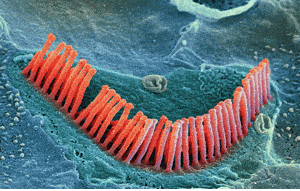
Hair cells located in the organ of corti, in the cochlea of the inner ear.(c) SPL / Photo Researchers, Inc
A stroke of pioneering science, researchers have managed to restore hearing to a significant level in guinea pigs by using gene therapy, bolstering hope for a similar procedure to cure human deafness in the future.
The therapy works by promoting the regeneration of hair cells in the cochlea, the part of the inner ear which registers sound. These hair cells act like tiny dishes that catch infinitezimal fluid motion and transmit them into nerve signals to the brain, which we typically recognize as sound. These tiny hairs are incredibly sensitive, and it’s common for them to deteriorate or even get completely distroyed when exposed to loud sounds, certain drugs or old age, ultimately.
“It’s the first time anyone has biologically repaired the hearing of animals,” says Yehoash Raphael at the University of Michigan in Ann Arbor, Michigan, and head of the US-Japanese team that developed the technique.
For their research, the scientists first destroyed the inner-ear hair cells in guinea pigs. Then they injected a specially engineered adenovirus, the key to the treatment. This virus is completely harmless and contains a gene called Atoh1 or Math1, which gets infused to the cells inside the scala media, the chamber where the tiny hearing hairs lye. The gene then generates a signalling molecule known to orchestrate the development of hair cells in embryos.
“The recovery of hair cells brought the treated ears to between 50% and 80% of their original hearing thresholds.”
By all means, these are incredible results. Moroever, the researchers report that hair cells were generated from other cells lined in the scala media, meaning some cells had been turned into other cells. Incredible!
The researchers hope this therapy might be used in the future on humans, at least as a complementary measure for people already using hearing aid devices. Raphael says that the next experiments in guinea pigs will focus on this combination. However, guinea pigs are far different from humans. For one, the inner-ear is nested deep inside the skull for humans, making surgery extremely difficult*, and there’s always a big chance the immune system will reject the researcher’s engineered virus. Let’s hope for the best.
The researchers’ findings were published in the journal Nature Medicine.
*edit: in the initial draft of this article I wrote that inner-ear surgery in humans is impossible, which is a false statement. This type of procedure is difficult, but possible. Many thanks to Paul Harris for the input.









